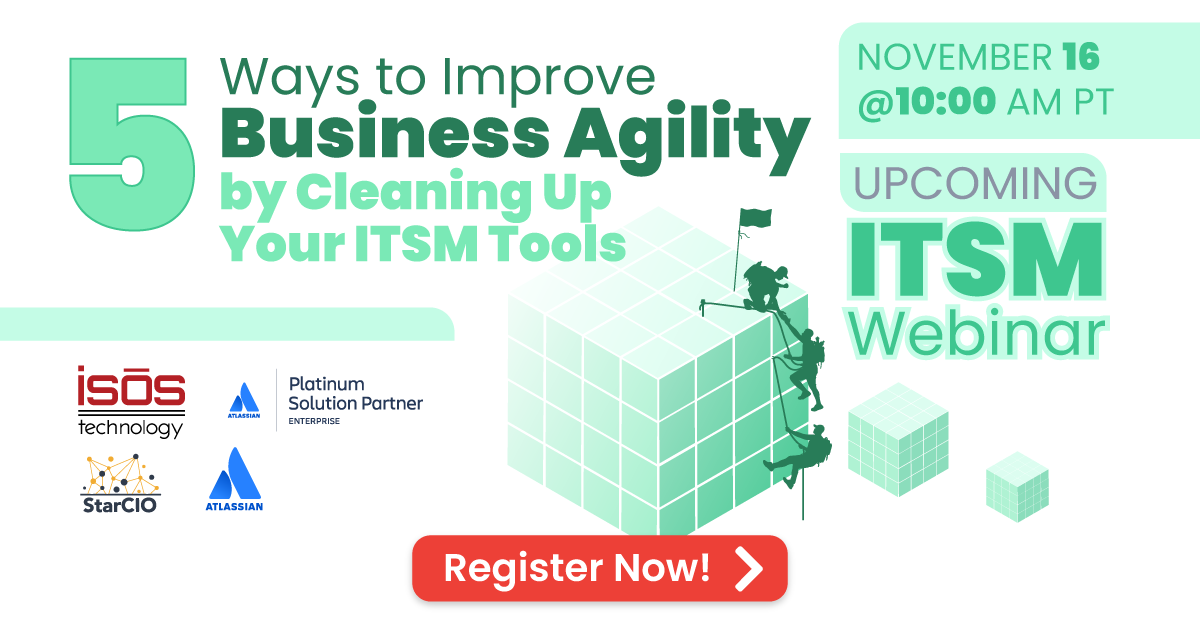Guest Contributor: Isaac Sacolick, President of StarCIO
 It’s that time, just before the end of the year, when you look around the house and ask a simple question. Are you ready for the winter months, visiting guests, and other holiday plans?
It’s that time, just before the end of the year, when you look around the house and ask a simple question. Are you ready for the winter months, visiting guests, and other holiday plans?
Many people use a three-step process to have their homes in order. They (i) clean up the mess, (ii) reconfigure the house for their near-term plans, and (iii) prioritize small home upgrades to make an enjoyable holiday season.
We do this so that our friends and family have an enjoyable experience while we try to avoid the stress from last-minute changes.
We can use similar thinking and approaches when looking to improve employee experiences with IT service management practices. The three steps – clean up, reconfigure, and prioritize small upgrades – are a foundation for how we can improve employee engagement and IT workflows in Jira Service Management (JSM).
Only we’re not thinking about the holidays, instead we’re thinking about how we can streamline JSM to prepare the IT services team for the next few quarters.
In the webinar that I moderate, 5 Ways to Improve Business Agility By Cleaning Up Your ITSM Tools, my panelists and I share best practices that fall across the three steps of cleaning up, reconfiguring, and prioritizing upgrades. For example, what should you clean up and simplify on request forms, how should you reconfigure ticket routing, and how should you prioritize consolidations from other ITSM tools or M&A business activities?
Take a user-centric approach when reviewing your JSM configuration
Last year, I wrote about how to clean up projects in Jira Software and shared five guidelines on how agile teams and DevOps organizations should configure projects, boards, and user roles. In this post, I share insights on how to think about JSM projects, request types, portal groups, and services.
Specifically, ITSM teams often have conflicting requirements and can fall into disconnects between:
- How they want the service desk to operate and improve operational KPIs
- How ITSM connects with other IT functions, including DevOps and teams adopting scrum
- What ITIL recommends as best practices when defining IT services
- How the business is organized, including business units, geographies, and departments
- How employees use technology services to complete their jobs efficiently and intelligently
These disconnects often lead to messy ITSM tool configurations, especially when IT consolidates from other ITSM tools, and M&A brings in new users and IT services.
So let’s look at cleaning up, reconfiguring, and prioritizing upgrades from three perspectives:
1. Defining how employees, executives, and other end-users understand IT requests
Last-gen ITSM tools (you know which ones I’m talking about) focused on IT’s workflow, so their configurations mimicked the IT organizational model and system responsibilities. Today, IT leaders know that businesses measure ITSM’s performance by how effectively IT service desk employees respond to employee requests, how quickly incidents get resolved, how efficiently IT is resolving problems, and how well IT communicates with everyone in the organization.
The implication is that ITSM tools must be configured using business-friendly terms and configurations that are simple for employees to navigate. While poor employee satisfaction (ESAT) scores and long resolution times are problematic, not hearing about issues from employees and watching them perform heroic workarounds instead of asking IT for help is a disaster.
Here are four recommendations for JSM implementations to help you avoid a disaster in the future:
- Learn where JSM is working well for employees and what improvements are needed. Ask employees what request types are most important to them, which ones they don’t understand, and which ones are irrelevant to their jobs. Review the last 6-18 months of utilization by request type, incident services, and other dimensions. Feedback is your primary tool for driving improvements.
- Simplify the number of portal groups and request types so that employees can easily pick one, even if it’s not the perfect selection. You can always reroute a ticket if it’s misassigned, but only if you received the request.
- Review the forms, especially for the most common requests, and see where there’s an opportunity to reduce to a smaller number of essential fields.
- Improve customer communications so that they are useful to end-users. JSM comes preloaded with ten request communications with basic default text. Top-performing service management teams improve on these basics by sending rich, contextual communications that end-users find helpful.
2. Make it easy to open an incident ticket
Similar to managing requests, simplify the incident escalation forms so people can use them quickly and easily. No one wants to go through a long form to report an outage, and most IT teams can’t afford to have employees call, email, or knock on the door when systems are having performance issues.
Small organizations should reduce the out-of-the-box JSM configurations for urgency (critical, high, medium, and low) and impact (extensive, significant, moderate, and minor) to fewer options and consider relabeling them to improve business context. For example, in hospitals, manufacturing plants, and other places where there are human safety concerns, you might want to rename an impact called “life threatening” or “human safety concern” instead of generic language like “extensive.”
A second recommendation is to connect incidents with services. If there are only a few services in JSM and Opsgenie and they are in business-friendly terms, add the “Affected services” field to incident forms. This field should create enough starting context to route the ticket to the right people, who can then follow up and capture the most useful details
3. Configure operations based on a path of fulfillment
Keeping a few simple request types and service definitions enables IT to redefine its operations based on efficient fulfillment flows. For example, incident SLAs for response and resolution times can be configured to match the business requirements for each service, and automations can assign requests based on portal groups and request types. Thus, cleaning up the request types and service configurations enables efficient workflow and useful automations.
The simplified taxonomy also helps when there’s an opportunity to consolidate off of another platform, such as ServiceNow or Cherwell. Instead of porting their configurations into JSM, ITSM leaders can reapply a simplified fulfillment model in JSM to new teams and the systems they support, transitioning from these other systems.
Learn more details about cleaning up, reconfiguring, and prioritizing JSM improvements in the webinar, 5 Ways to Improve Business Agility By Cleaning Up Your ITSM Tools.
Isaac Sacolick, President of StarCIO, guides companies through smarter, faster, innovative, and safer digital transformation programs that deliver business results. He is the author of the Amazon bestseller, Driving Digital, and his new book, Digital Trailblazer: Essential Lessons to Jumpstart Transformation and Accelerate Your Technology Leadership. Isaac is an industry speaker and blogger at Social, Agile, and Transformation. StarCIO offers three agile planning courses for stakeholders, teammates, and certified StarCIO Agile Planners.
Sign up to receive more great content
Learn more about Atlassian and how Isos can help by signing up to receive our latest blogs, eBooks, whitepapers and more.














